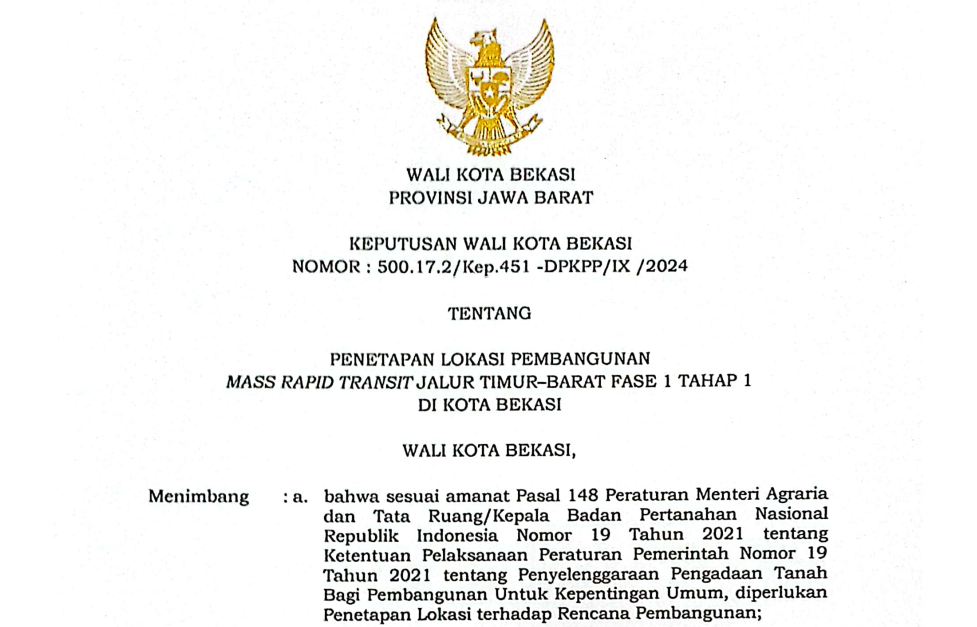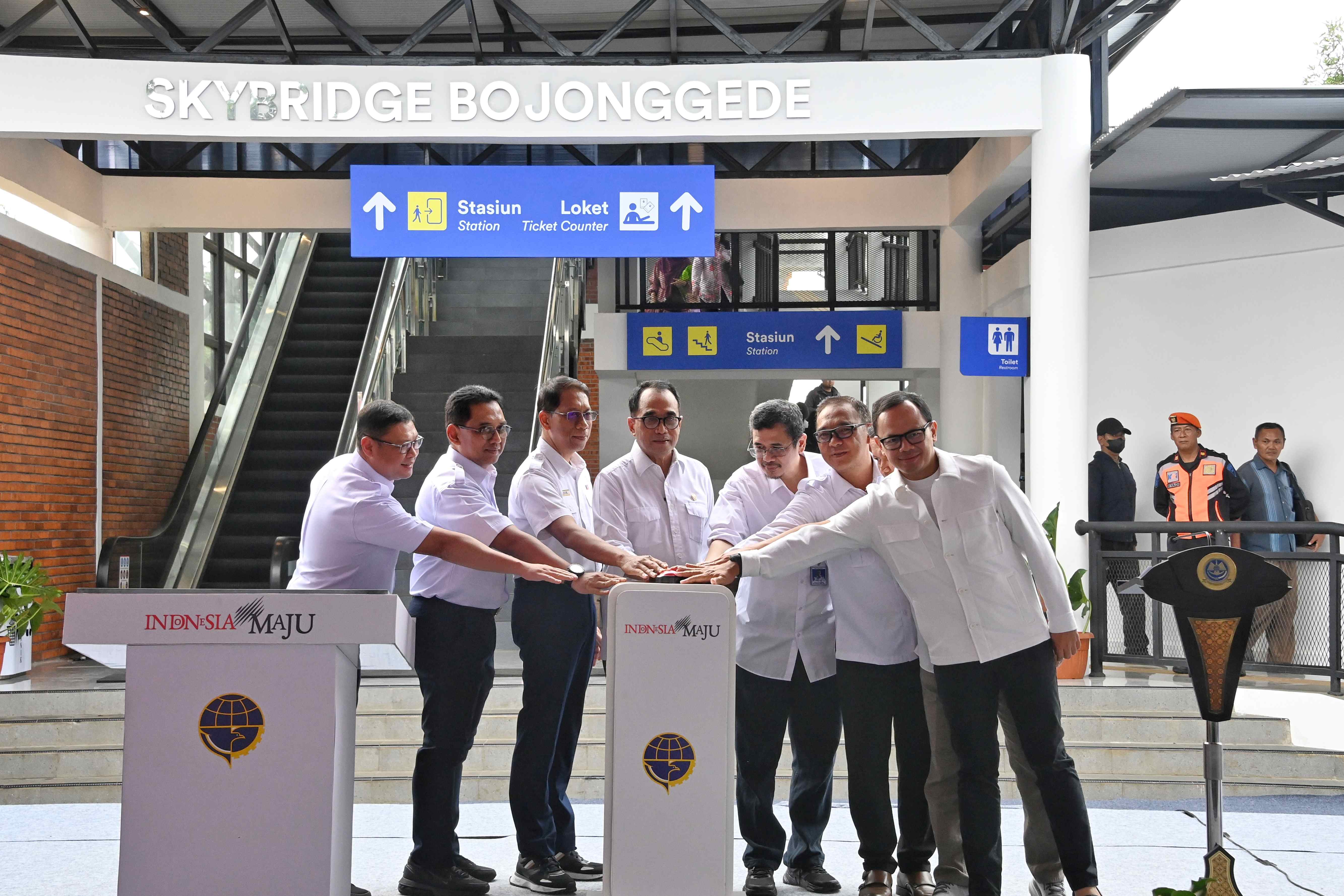TECHNICAL WORKSHOP "EXCHANGE OF INFORMATION ON THE APPLICATION OF SMKP BY RAILWAY OPERATORS".
Person in charge:
Ir. Erni Basri, S.T., M.Eng.IPM., ASEAN Eng., QRMP (Director of Railway Safety)
Steering Committee:
Hendrialdi, ATD., M.T (Head of Safety Audit and Inspection Sub-Directorate)
Gunadi Raharjo, S.T., M.M.Tr (Safety Audit Coordinator)
Editor:
Peggi Lhucita Ruliyan, SKM (Staff of Sub-Directorate of Security Audit and Inspection)
Writer:
Miftakhul Janah, S.Ikom (Public Relations Officer)
Railway transportation requires high safety standards in every operation. The complexity of the entire railway system makes it difficult to accurately analyze and ensure the safety of the system. Risks due to this increased complexity can be mitigated through railway safety audits. In an effort to continuously improve railway safety, the Directorate of Railway Safety, through the Sub-Directorate of Safety Audit and Inspection, has organized a Technical Guidance on Safety Audit with the theme "Sharing Session on the Implementation of Railway Safety Management System by Railway Operators".
The activity, which was held in Surabaya on October 4 and 5, was attended by Transportation Policy Agency, Secretariat of General Directorate of Railways, Directorate of Railway Traffic and Transport, Directorate of Railway Infrastructure, Directorate of Railway Facilities, Railway Engineering Center, Railway Testing Center, Railway Maintenance Center, South Sumatra Light Railway Management Center, South Sulawesi Railway Management Center, PT KAI Headquarters, PT KAI Jabodebek LRT Division, PT KCI, PT KCIC, PT MRT Jakarta, PT LRT Jakarta, PT Railink Indonesia, PT Angkasa Pura II (Soekarno-Hatta Airport Elevated Train), and PT Celebes Railway Indonesia.
The technical guidance activity was opened by the Director of Railway Safety and continued with the delivery of material by the resource person.The presentation was followed by a discussion and question and answer session with the technical guidance participants. The participants included all stakeholders within the Directorate General of Railways.
Erni Basri, Director of Railway Safety in his speech said that this technical guidance activity is a routine agenda of the Directorate of Railway Safety as an effort to provide guidance so that the operational safety of railways and the safety of railway human resources can be guaranteed in accordance with the Government Regulation No. 6 of 2017 concerning amendments to Government Regulation No. 56 of 2009 concerning the implementation of railways.
The method of technical guidance is Sharing Session of railway operators. Operators can share their experiences in the implementation of the Railway Safety Management System in order to find the right solution to the obstacles and challenges they face. A total of 8 (eight) resource persons shared their knowledge and experience on the implementation of SMKP, including Integrated Management System, Urban Safety Management System, Optimization of Company Resources, SMK3, etc.
The speakers in this technical guidance were Anggandanu from PT MRT Jakarta, Miming Kuncoro from PT KCIC and Saesario M. S. Ridwan from the Ministry of Manpower as OHS expert. Then the speakers were Ugi Noviandi from PT KAI Jabodebek LRT Division, Sigit Winarto from PT KAI (Persero), Broer Rizal from PT Kereta Commuter Indonesia (KCI), Yosa Merina Fahri from PT LRT Jakarta and Eko Agus Purnomo from the National Standardization Agency (BSN). The material presented by the speakers was the implementation of the Railway Safety Management System.
Anggandanu from PT MRT Jakarta shared the implementation of the Integrated Management System. In this case, the company starts by studying traffic safety systems from other sectors and ministries. It then implements policies that prioritize good corporate governance and customer satisfaction, service and operational excellence, compliance with regulations, and have continuous improvement targets, including zero accidents, zero discharges, zero defects, zero delays, and zero crimes. MRT Jakarta actively implements corrective actions and continuous improvement based on OHS performance analysis, compliance assessment, audits, management reviews, and the needs of stakeholders. The company has also developed an integrated risk assessment system for various risks and DINAMIQ as a web platform for information related to OHS findings, work status and approvals.
Miming Kuncoro said PT KCIC has developed a SMKP manual that includes 38 procedures and 24 rules adopted from the China Railway Safety Management System. Where regulations on railway safety protection are issued by the State Council. KCIC implements SSHE (Safety, Security, Health and Environment) work in every work activity. In general, the safety management principles applied in China and Indonesia are the same, namely the use of the PDCA (Plan, Do, Check, Action) management system framework.
Regarding the Railway Safety Management System (SMK3), Saesario M.S. Indrawan, ST. ACPE, who is an OSH expert from the Ministry of Manpower.The 5 points of importance of OHS in the workplace are legal compliance with OHS regulations, worker welfare, increased productivity by achieving zero accident goals, company reputation and cost savings. Investing in OHS may cost money up front, but it can save money in the long run. SMK3 is part of the overall business management system to control the risks associated with work activities to create a safe, efficient and productive workplace. The hierarchy of hazard control is like an inverted pyramid, the first thing to do is elimination, which is to remove the source of risk by eliminating the work, if elimination is not possible then substitution is to replace the source of risk with safer materials, equipment or methods, then modification is to improve the source of risk through engineering, then management is to reduce the risk through a series of procedures, training, and finally the use of personal protective equipment (PPE).
Ugi Noviandi from PT KAI Jabodebek LRT Division said that Jabodebek LRT has implemented the Integrated Management System ISO 9001 - ISO 14001 - ISO 45001, SMK3 and SMKP. This is done to integrate the same management system requirements into one framework, which means that the main purpose of the Integrated Management System is to be used by organizations that implement two or more requirements of the Management System Standard (SSM).
Sigit Winarto from PT KAI (Persero) gave an overview of the concrete steps taken by the company in implementing SMKP. Since 2009, with the establishment of EVP SHE, the company has continued to develop SMKP in cooperation with safety consultants, established a safety management system (SMS) framework, and conducted training and socialization of safety risk management. In 2020, PT KAI issued a board of directors' regulation on SMKP with reference to PM 69/2018. The implementation of the safety committee is done through the establishment of a central safety committee and regional safety committees (Daop, Divre, and Balai Yasa). In addition, a safety action group has been established where the safety committee meets every month.
Broer Rizal of PT Kereta Commuter Indonesia (KCI) discussed the challenges in implementing SMKP, both internal factors covering aspects such as communication, resource allocation, continuous improvement, document maintenance and storage, regulatory compliance, and safety culture. External factors include public communication, investment, data management, human factors, infrastructure age, infrastructure complexity, technology development, change management, passenger volume, intermodal integration, emergency management, and regulatory compliance. PT KCI implements an effective strategy that includes strong commitment, setting clear goals and objectives, establishing effective communication, implementing a safety culture, allocating resources, organizing safety documentation and records, periodic internal and external audits, and establishing safety as part of the Key Performance Indicator (KPI). The main goal emphasized is to achieve zero accidents, zero train accidents, zero train incidents, and zero environmental incidents.
As for the explanation of Yosa Merina Fahri in the implementation of SMKP, PT LRT Jakarta implements SMKP through the QSSHE (Quality Safety Security Health Environment) management system to ensure that quality, K3, railway safety, security and environment are well managed. The steps start from planning, policy setting, implementation, evaluation and improvement, and comply with applicable laws and regulations. The company prioritizes good corporate governance and customer satisfaction, focusing on zero accidents, zero discharges, zero defects and zero delays. PT LRT Jakarta also implemented an integrated QSHE e-Document system to facilitate access and document management via PC and smartphone devices.
Speaker Eko Agus Purnomo from the National Standardization Agency spoke about the quality management system. Process and system management can be achieved through a risk-based PDCA cycle. ISO developed the Occupational Health and Safety (OH&S) management system standard to help organizations manage OH&S risks and improve OH&S performance. The quality management system and the occupational health and safety management system can be integrated into the organization's management process.
With this technical guidance activity, in addition to being a forum for exchanging information and solutions in dealing with the obstacles and challenges of implementing the Railway Safety Management System (SMKP), it also shows awareness of the complexity of the railway system and the importance of SMKP in dealing with risks and ensuring overall operational safety, so that the objectives of implementing SMKP to improve planned, structured, measurable and integrated railway safety, to prevent incidents and/or train accidents, and to create a safe, secure, comfortable and efficient railway HR workplace and environment can be achieved.(MJ)





.jpeg)
Komentar
LOGIN FOR COMMENT Sign in with Google